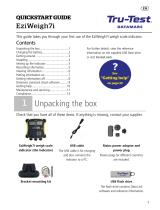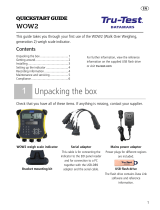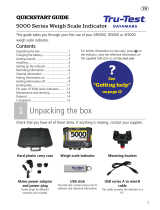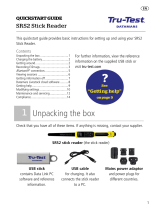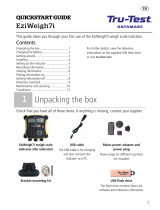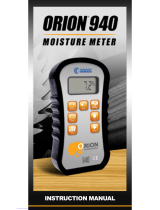Page is loading ...


Datamars recommends the use of Jenquip Pasture Management Software. It takes the
information from your farm walk and produces ready-to-use reports. Jenquip Pasture
Management Software is supplied with your plate meter on a USB stick. For all support,
phone 0800 AGDATA (0800 243282) in NZ, or 1800 248 774 in AU.
Computer requirements: Windows XP or later.
© 2018-2019 Datamars Limited
All product names and brand names in this document are trademarks or registered trademarks of their respective
holders.
No part of this publication may be photocopied, reproduced, stored in a retrieval system, or transmitted in any form or by
any means, electronic, mechanical, photocopying, recording or otherwise without the prior written permission of
Datamars Limited. Product specifications may change without prior notice.
For more information on other quality Datamars brands and products, visit www.datamars.com
Datamars Limited
25 Carbine Road
Mt Wellington
Auckland 1060
New Zealand
Postal address:
P O Box 51078
Pakuranga
Auckland 2140
New Zealand
Datamars Limited, 2019. All rights reserved.
835156 Issue 1 05/2019

Introduction ......................................................................................................1
Assembly instructions .......................................................................................2
Operating the plate meter ................................................................................6
Zero calibration ................................................................................................8
Start up/self test .............................................................................................10
Entering the factory default formula ...............................................................11
Other formulas: ..............................................................................................11
Entering your own formula .............................................................................12
Using your plate meter ...................................................................................13
Taking paddock readings (the pasture walk) ..................................................14
Software .........................................................................................................15
Maintenance...................................................................................................16
Fault finding ...................................................................................................17
Warranty and servicing ...................................................................................20


1
Congratulations on the purchase of your Tru-Test EC-09 Plate Meter. This plate
meter is a high precision engineered device for measuring the average height of
pasture relative to density of the pasture.
This is directly relative to the quantity of dry matter present (kilograms of dry matter
– kg DM/ha)
Your plate meter will become an invaluable tool in your farming operation for
day-to-day feeding decisions and long term feed budgeting.
Read and understand all the instructions before using the plate meter. A copy of this
user guide can be downloaded from www.livestock.tru-test.com
Your plate meter is designed only for measuring pastures. Use it for no other purpose
(e.g. it is not a walking stick). We have manufactured the plate meter using quality
materials and manufacturing techniques, however, if faults do occur, have them
corrected before you use the plate meter.
Be careful around electric fences. Parts of the plate meter will
conduct electricity!
Store the plate correctly. Be careful that the wind does not blow the plate away - it
could be dangerous. It is not to be thrown.
Water blasting or submerging the unit will void the warranty.

2
The plate meter is supplied in three parts:
The heavy duty plastic plate sits on top of the pasture to establish average height
and density. The area of the circle and weight of the plate have been carefully
calibrated.
The grooved rod allows pasture to be measured in 0.5 cm intervals (clicks). The
yellow shaft includes the electronic meter.
The black handle can be adjusted to suit the height of the user.
To assemble the plate meter:
1 With one hand, hold the yellow shaft
vertically with the counter towards the
ground. The grooved rod will slide
down through the shaft.

3
2 With your other hand, screw on the
plate, making sure that the smooth
side of the plate is uppermost (ribbed
side closest to the meter).
3 Turn the plate meter the correct way
up (plate down) and place it on the
ground. The grooved rod will protrude
out of the shaft. With one hand hold
the grooved rod and with the other
hand, screw on the black plastic
handle. Be careful not to displace the
small rubber O-ring on the top of the
rod.
4 Use the buttons on the handle to adjust the handle so that it is a
comfortable height.

4
1 Screw the top handle (black in some
models) into the grooved rod.
2 Turn the grooved rod upside down and slip
off the O-ring.
3 Put four drops of thread locker into the
female end.

6
The plate meter is switched on and off using the black switch at the back of the unit.
Off is in the ‘down’ position. When the unit is off, there are no numbers displayed
on the LCD screen.
The various functions of the plate meter are accessed by the two buttons on the
front of the unit, labelled ‘Height/Reset’ and ‘Count/Formula’. The words in bold
type are the primary functions.
These are activated by a short press of the button. The secondary functions ‘Reset’
and ‘Formula’ are activated by holding the button down until the function operates.
When the unit is first switched on, the display will show the current formula in use

7
and the calculated kg DM/ha based on that formula, and any readings in memory.
Pressing the “Height” button will briefly display the average pasture height. This is
often referred to as “clicks” (measured in 0.5 cm) and will be displayed to one
decimal place (i.e. 0.0 or 12.4).
1 click = 0.5 cm.
The number of readings is displayed when the ‘Count’ button is pressed. The display
will show a ‘c’ on the left side and the count on the right. The display will return to
normal after two seconds.
All readings can be cleared (reset) by holding down the “Reset” button for
approximately two seconds, then the display will change to “0”.

8
To ensure that the plate meter accurately measures the compressed height of
pasture, the plate meter must be calibrated. This requires setting a base level of zero
so measurements can be benchmarked against this. If the plate meter does not
return to zero after each reading, it will not record the measurement - hence the
plate meter will not beep.
If, for any reason, the plate meter is out of calibration, it will need to be recalibrated.
To calibrate the plate meter:
1 Hold the plate meter at the bottom of travel and ensure that the plate
meter is switched off.
2 Locate the zero adjustment screw (beside the On/Off switch).
3 Remove the protective rubber bung by levering it out gently using a flat-
bladed screwdriver.
4 Hold down the “Count” button while switching the unit on. The display
will change to “CAL” briefly and display a colon (:) followed by a number.
The colon (:) signifies that it is in fine calibration mode.
As an example, you might see “:5” when you switch on.
5 Using the flat bladed screw
driver, turn the yellow plastic
or steel shaft within the cog,
anticlockwise, until the
display reads “0”.
The cog and steel
shaft must remain
stationary.
Do not turn the
shaft beyond this
point or you may
damage the plate
meter and void the
warranty.

9
6 Once the counter reads zero, move the plate meter up the full length of the
shaft. The colon will disappear once it passes 9 and enters “clicks” mode.
At the full height the display should read approximately “50” which is 50
half centimetres. The plate meter has now been calibrated.
7 Switch off when you have finished, and then back on again without
pressing any buttons.
8 Test the zero calibration by raising and lowering the plate all the way to the
bottom several times. A beep should sound and the kg DM/ha displayed as
the plate falls. If it does not, repeat the steps above and retest.
9 When you have finished calibrating the plate meter, replace the rubber
bung over the zero adjustment screw.
If the calibration fails to hold, then the potentiometer, which the cog drives, is
probably faulty and will need replacing. This can occur with excessive wear often
compounded by dust and dirt entering the dry bearing of the potentiometer.

10
1 Switch on.
The plate meter will beep and display the current formula setting. The formula
will be displayed next with the ‘+’ part of the equation first (default 500) and
then the ‘x’ part second (default 140).
2 The display will then show the kg DM/ha calculation based on that formula
and any readings stored in memory.
3 To clear the readings, press and hold the ‘Reset’ button until the display
shows ‘0.0’ There is one default plate equation, and one custom (user
editable) equation. The former is built into the chip and cannot be replaced or
modified. This equation is typically used between April and September in New
Zealand.
During start up, if the battery charge is low it will display “Lo” and give two beeps.
It will still work OK for some time. However, it would be a good idea to take a spare
battery with you on the farm walk.
The original formulas developed for use with the plate meter were:
Dairy Pasture (Reasonably consistent rainfall areas height reading x 158 +
1000 = Cover (kg DM/ha).
Dairy Pasture (moderate rainfall periods height reading x 158 + 200 = Cover
(kg DM/ha).
Sheep pastures: height reading x 158 = Cover (kg DM/ha).
The plate meter also provides an option for selecting your own equation or those
recommended by consultants, such as Dairy NZ or Beef + Lamb New Zealand. Your
plate meter will be set up for the Dairy NZ recommended equation for the
autumn/winter months.

11
While the plate meter is switched on, hold down the ‘Formula’ button. The display
shows ‘F_ _ d’ Press the ‘Reset’ button briefly. The display will then show (500) and
then (140). The default formula has now been loaded and saved to memory.
To better reflect the growth stages of pastures, these formulas were derived:
1 Winter & early spring - before stem growth x125 + 640
2 Late spring & early summer - during stem growth x130 + 990
3 Mid summer x165 + 1480
4 Early autumn - before autumn rain x159 + 1180
5 Late autumn - after rain x 157 + 970
Dairy NZ also developed these month based formulas:
Months
(Southern hemisphere)
Plate meter equations
(Dairy pastures)
Winter (April/September)
Plate meter reading x 140 + 500 (factory
default)
October
Plate meter reading x 115 + 850
November
Plate meter reading x 120 + 1000
December
Plate meter reading x 140 + 1200
January
Plate meter reading x 140 + 1200
February
Plate meter reading x 185 + 1200
March
Plate meter reading x 170 + 1100

12
Months
(Northern hemisphere)
Plate meter equations
(Dairy pastures)
Winter (October/March)
Plate meter reading x 140 + 500 (factory default)
April
Plate meter reading x 115 + 850
May
Plate meter reading x 120 + 1000
June
Plate meter reading x 140 + 1200
July
Plate meter reading x 140 + 1200
August
Plate meter reading x 185 + 1200
September
Plate meter reading x 170 + 1100
Some equations may change without notice and are influenced by
seasonal differences. If you are unsure of the current equation contact
Dairy NZ or your local consultant.
To enter your own cover equation or one that may have been recommended by a
third party, such as your consultant, Dairy NZ or Beef + Lamb New Zealand, please
do the following:
1 While the plate meter is switched on, hold down the “Formula” button. The
display looks like this: “F--d”. Press the formula button again briefly - then
change the “d” (default) to “c” (custom). Now press “Reset” briefly and the
display will look like this: “0---” This is the first of two numbers you will enter.
The first number is the equation “add” number and the second the “multiply
number. For example, in equation 2 above, the first number (115) is the
“multiply” number and the second (850) is the “add” number.
2 The “add” number is 4 digits long and can range from 0 to 9999. Starting
with the first digit, press the “Formula” button to change this digit to a value

13
from 0 to 9. Press the “reset” button when it is correct. NB, 850 for example
would be entered as (0850). Enter the next digit. Repeat this process until all
4 digits have been entered. The display then changes to the “multiply”
number.
3 The “multiply” number has 3 digits and can range from 0 to 255. The first
digit will appear. Press the “Formula” button to change this digit to a value of
0, 1, or 2. Press the “Reset” button when it is correct and the next digit will
appear. Repeat this process until all digits are entered and the display returns
to its normal state.
As manufacturers we can only give broad guidelines with regard to the formula to
use. For advice on creating custom formulas optimised for your particular farm, and
circumstances contact 0800 AGDATA (0800 243282) in NZ, or 1800 248 774 in
AU.
Practice the technique of an uninterrupted slow walking pace, taking care not to
“roll” the plate meter. This is where the plate is not square to the ground and it will
provide a false HIGH reading.
Lowering the plate meter consistently rather than rolling it, will
provide a more accurate reading.
The more regularly you take readings the better. Astute farmers will take readings
weekly, sometimes more often during critical times of the year and less frequently
during times of static conditions.
The more samples taken per paddock the less margin of error. We recommend 20
to 40 samples per paddock but if you have bad conditions ie. pugged paddocks,
then more samples should be taken.

14
Most paddocks will have areas of good growth and areas of poor growth. If recently
grazed, the pasture may be clumpy. Ensure that your walk includes representative
samples of both areas. Avoid tracks, stock camp sites and other uncharacteristic
areas.
Take samples every 3 paces or so, rather than choosing by eye the spot to sample.
This removes operator preference for long or short patches.
Be consistent. Plan the same walk every time although it can be
done in reverse. This allows each walk to be compared with another.
1 Switch the unit on using the toggle switch at the back.
2 Reset by holding the ‘Reset’ button until the display changes to ‘0’. This
should be accompanied by 2 short beeps.
3 Walk across the paddock taking readings every few paces. You will hear a
beep every time a reading is stored. The average kg DM/ha is immediately
recalculated and displayed. The number of samples (readings) to be taken
should range between 20 and 40 per paddock however this will be
determined by the variance existing in the cover. You will hear 3 short beeps
when you have completed 29 readings and one long beep when you reach
30. This is the recommended number of readings. Readings need to be taken
on a regular basis e.g. every three paces to even out any variations, however
avoid stock camp areas, tracks or uncharacteristic areas. The greater the
variability, the greater the number of readings you should take.
4 If you need to negotiate an obstacle (e.g. fence or creek) switch the unit off so
that no readings are taken if the plate moves. On the other side of the
obstacle, switch the unit back on and continue taking readings.
5 When you have completed the paddock, read off the average pasture cover.
6 Write down the average height and/or the average cover.
7 Repeat instructions 4 to 8 until you have completed every paddock.

15
8 Switch the unit off using the toggle switch at the back.
Undo Feature: You can “undo” the last reading by holding down
the “Height” button as you switch on the plate meter. The count will
now be one less than what it was and the dry matter reading will
also change to the previous reading. You can continue taking more
readings if you wish.
Results from feed budgeting will assist in making important management decisions
such as:
Stocking rates
Quantity of feed supplements to feed
When to apply nitrogen fertiliser
Predicting future shortages or surpluses of pasture
Planning silage and hay making
Drying off times
Stock sale decisions
Highlighting poor performing pastures or paddocks
Datamars recommends the use of Jenquip Pasture Management Software. It takes
the information from your farm walk and produces ready-to-use reports. Jenquip
Pasture Management Software is supplied with your plate meter on a USB stick.
Use the Jenquip Pasture Management software to further process the plate meter
readings and do your feed wedge:
Total Dry Matter = Kg Dry Matter per Hectare x Paddock Area
Growth Rate of Pasture
= Final kg DM/ha - Initial kg DM/ha (kg DM/ha/day)
Number of days between samples

16
Your plate meter has been developed over a number of years to be simple, effective
yet reliable. However, a little maintenance will ensure many years of trouble free use
from this plate meter.
After assembling the plate onto the meter, move the plate up and down a few times
to ensure no binding occurs. If its movement is restricted, the reason must be
identified and resolved before the plate meter is used.
Remove the plate and wash it clean.
Wash/wipe and dry the area around the bottom of the plate meter. Move the plate
meter up or down the shaft so that all dirt and accumulated grass can be washed
away.
This is a precision instrument - look after it.
Water blasting or submerging the unit will void the warranty.
On start up if you get a “Lo” battery warning then the battery will need replacing
over the next farm walk or two. A triangle icon in the top left hand corner also
indicates a low battery. The plate meter is powered by a single 9 V battery. The use
of an alkaline battery is recommended though a standard heavy duty battery will
still work well. An alkaline battery should give 40-50 hours continuous use. A NiCad
rechargeable battery may also be used.
Before you replace the battery, ensure that the plate meter is switched off. Remove
the screw on the front of the plate meter. The battery retainer will slide out towards
you.
Remove the battery and gently remove the battery snap connections (lever off with
a screwdriver). Fitting the new battery is the reverse of the removal procedure.
If your battery is near the end of its life, it is a good idea to carry a spare with you.
/





